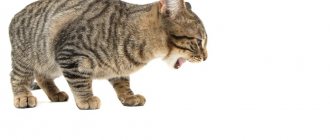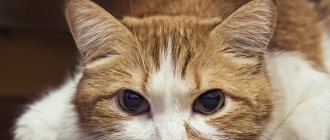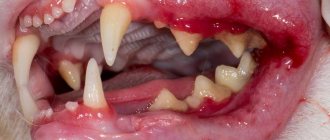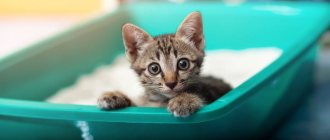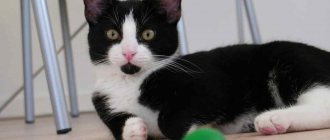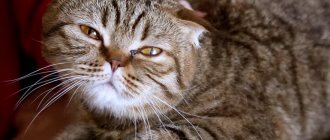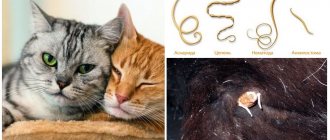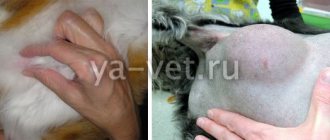When a pet has health problems, the first thing the cat is sent for tests, including a urine test. This study is carried out without fail; this analysis is required if kidney pathologies are suspected. Urine collection can be carried out in a veterinary clinic by a veterinarian, or the owner can independently collect urine from the pet. In the future, it will need to be taken for laboratory analysis. In this article we will introduce you in more detail to the indicators that are present in a urine test.
Physical indicators
Quantity
In cats, almost 70% of all liquid consumed is excreted in urine. The daily dose of urine in a cat will depend on the following aspects: the functioning of the genitourinary system, the functioning of the sweat glands, the composition of the feed, as well as the functioning of the kidneys and gastrointestinal tract. Normally, an adult cat produces 20-30 milliliters of urine in 24 hours.
An experienced veterinarian will be able to detect the presence of certain diseases based on the volume of urine.
Color
The color of urine can determine not only the presence of pathologies, but also what the cat eats and what medications it takes. The normal color of urine is yellow and all shades of yellow.
Specific gravity
This indicator is also called specific gravity, it shows how much solids are dissolved in the urine. This indicator can vary greatly during the day, as it depends on the functioning of individual organs, as well as on food.
In cats, the average specific gravity is 1.020 1.035 grams/l. If the indicator is slightly too high, this may indicate dehydration of the cat’s body. If the density is significantly lower than normal, this indicates the development of renal failure or other pathologies.
Precipitation, transparency
If sediment or visible flakes are found in the cat’s urine, then most likely there are inflammatory processes in the body. With laboratory analysis, specialists will be able to identify the source of these sediments.
Urine in the room should be completely clear. To check its transparency, you can pour it into a narrow flask, and attach a magazine or newspaper to the other side. If you can read the text without any problems, then everything is fine with the clarity of your pet’s urine.
Smell
The normal smell of urine in furry cats is specific and not strong. The smell may differ from the norm, and this mainly happens for the following reasons:
- Rot. If your pet's urine smells rotten, then most likely there are several areas of rot in the urinary tract. In this case, you should immediately contact a veterinarian.
- Acetone. Many cat owners know that if the urine has a strong smell of acetone, it means the cat has diabetes. In rare cases, this symptom may indicate another pathology - ketosis.
- Ether. This smell indicates that your pet has become infected with roundworms. The diagnosis is not 100%, so it is necessary to undergo examination at a veterinary clinic.
- Ammonia. If after going to the toilet you smell ammonia from the litter box, then you need to urgently take the cat to the hospital. Since in 90% of cases such a symptom indicates inflammation of the bladder.
- Cal. The smell of feces can indicate only one pathology - paraproctitis.
Reaction
The reaction of urine is determined by acidity, this indicator is measured in pH units. The reaction in cats is considered slightly acidic, since they eat mainly meat products. In the morning this indicator will be very low, and maximum after eating.
The pH environment is also checked for various pathologies and during treatment, since in this way it is possible to monitor the effectiveness of treatment.
Consistency
Normally, urine in cats should be liquid, that is, it will flow like water from one container to another.
With pathologies associated with the kidneys, the consistency may become jelly-like or even jelly-like. If you find such abnormalities in your furry, you should immediately take him to see a veterinarian.
Cat urine
We know that a cat's nature is to be a hunter, so it marks its territory to see who's in charge.
There are many situations in which a cat can use urine to sign the space in which it moves:
- The male does this when he senses the presence of a male cat in heat, obviously both of them are not sterilized: in this way he releases sex pheromones to attract the female cat;
- When he senses the presence of strangers: his urine mark indicates that he does not want them on his territory;
- The cat is in a state of severe stress: a calm environment in the house, the loss of the owner, the appearance of new animals or a child, a change of home.
However, usually the cat performs its physiological function by choosing a place to urinate: sometimes it does not coincide with the litter box, and a number of mechanisms must be put in place to teach him to use it.
© shutterstock
A cat's feline nature also comes into play when she pees: she digs deep and then covers it up, all solely so that the victim does not smell her and can escape.
Without interfering too much with his cat's lifestyle, we should observe the cat even when he is fulfilling his needs to understand whether he is healthy or if there are any problems.
It is also important to pay attention to the cat's behavior during urination, in addition to its color, noting if:
- the cat no longer pees;
- feels the urge but struggles to pee;
- despite the fact that he has been trained to use the litter box, he anxiously looks for a corner where he can do this;
- he makes strange noises while trying to shrink;
- since he cannot write, he refuses to eat;
- he is restless.
These are already alarm bells that force us to contact the veterinarian: based on what we noticed by observing the cat and analyzing his urine, the veterinarian will be able to better explain the situation.
Chemical indicators
Glucose
Normally, glucose should not be present in the urine. But this sometimes happens, for example, if the cat is experiencing anxiety and stress or has diabetes.
Protein
Protein is not found in urine because it is formed during the process of cellular breakdown. If protein is found in the urine, then most likely this is a pathology; sometimes this happens due to severe hypothermia. Kidney failure, cystitis, inflammation of the bladder, pyelonephritis, cystitis, diabetes mellitus. All of the previously listed diseases can lead to protein entering the urine.
Ketone bodies
Ketone bodies are acetone, as well as some acids, which are actively produced by the pet’s body during fasting or stress. Determining the presence of ketone bodies is quite simple, since the urine will smell strongly of acetone.
Bile pigments
Urobilinogen and bilirubin are the main bile pigments and are produced by the liver. Based on their number, we can talk about how the liver functions. If the number of pigments increases sharply, this indicates that the body is being poisoned by toxins. Sometimes the level of pigments increases due to inflammation of the bile ducts.
Hemoglobin
In a healthy state, cats do not contain hemoglobin in their urine; it is formed only if the cat is severely intoxicated. They can occur due to the ingestion of poisons into the body (lead, arsenic, poison of insects and other animals). In such a situation, hemoglobin is formed during the breakdown of red blood cells, and then it ends up in the urine. The presence of hemoglobin can be detected by the dark brown color of the urine.
Red blood cells
When red blood cells enter urine, it acquires a reddish tint. This is considered a deviation because the urine should not contain red blood cells. In 70% of cases, the entry of red blood cells into the urine indicates injury to the urinary system.
Nitrites
If nitrites are present in the urine, it means your pet has caught an infection somewhere and it has entered the urinary tract. A detailed blood and urine test will help identify the infection that has entered your cat's body.
Dark yellow urine color
It can occur in a healthy person due to dehydration: you don’t drink enough. This color of urine occurs when dehydration occurs due to vomiting or diarrhea, and also accompanies edema, for example, in heart failure (water is retained in the tissues, the person swells).
Usually there is no need to worry. Chances are you've eaten asparagus or foods with dyes. If you haven't eaten anything and your urine remains green, see your doctor - this could be a side effect of certain medications or a rare hereditary condition (hypercalcemia).
It may be a sign of jaundice - due to cholelithiasis or cancer of the head of the pancreas. Contact your doctor if your urine color persists.
Crystalline precipitation
Sperm
During catheterization, a small amount of sperm may be released into the urine. There is no deviation in this; all this data can be seen on the overall final analysis table.
Epithelial cells
The urine may contain a small amount of flat cells; the content of other cells is already considered a deviation from the norm.
Fat
In general, there should be no fat in the urine, but if a drop of fat is found in the daily dose of urine, then this is not a pathology. But if there is much more fat, then this indicates a metabolic disorder in the pet. In this case, treatment at a veterinary clinic is required.
Leukocytes
At 400x magnification, 0 to 3 cells should be visible on the microscope. If there are more of them, then such a deviation is called leukocyturia, and if their number exceeds 50, then pyuria. This type of urine is dark brown in color and smells like pus.
Urinary cylinders
Normally, urinary casts should not be present in urine. If such a deviation is observed, this indicates that the urine is too alkaline. Therefore, it is able to flush out the urinary ducts.
Vitamin C
By the amount of vitamin C, you can determine how things are with vitamins in the cat’s body. A daily dose of urine contains approximately 50 mg of vitamin C.
Bacteria
If the cat is healthy, then the urine should be sterile. If bacteria are present, it means there is inflammation in the genitourinary system.
Slime
Mucus in urine is contained in small doses. Its amount can increase during inflammatory processes in the body.
Mushrooms
Sometimes cats may have yeast in their urine when tested. They can enter the body along with anticancer drugs.
Diagnosis when urine is dark
If dark urine is detected in the tray, the cat should be shown to a veterinarian as soon as possible. First of all, the specialist conducts an external examination. Sometimes it is enough to identify the cause of the problem. More often, a general examination is required. It includes :
- general blood analysis;
- blood chemistry;
- Analysis of urine;
- Ultrasound of internal organs.
Based on the results of the examination, the cat is selected for therapy that is necessary in a particular case. If urolithiasis is detected, even surgical intervention may be required if large fractions seriously interfere with the flow of urine.
© shutterstock
Since general diagnostics require the cat to have an empty stomach, it is optimal not to feed him 12 hours before visiting the veterinarian. At the same time, his access to clean drinking water should not be limited in any way, which is very important for a normal picture during analysis. In case of a serious condition, or if the cat is weakening before your eyes, you should not wait and you must immediately show it to the veterinarian. Sometimes dark urine is a manifestation of emergency conditions.
How to collect urine for analysis?
Owners mainly use the following urine collection methods:
- Remove the litter from the tray and wash it with detergent. Wait until your pet comes to relieve itself, and then drain the urine into a sterile container.
- Sometimes cats are capricious and therefore refuse to go to the litter box without litter. In this case, you can put several paper napkins. When your cat goes to the toilet, squeeze out a small amount of urine into a container.
- If you are unable to take your cat’s urine for analysis, then contact a veterinary clinic. Experienced veterinarians will definitely be able to take a sample for research.
Try to have your urine analyzed at least once a quarter, as this way you can identify pathologies at the development stage.
Types of kidney failure
Depending on the course of the disease and its external manifestations, there are:
- Acute form – acute renal failure (ARF);
- The chronic form is chronic renal failure (CRF).
Both forms have similar characteristics, but develop differently.
Acute form
ARF develops very quickly. The signs of the disease are clearly expressed, which allows you to start treatment at an early stage, and this is extremely important for restoring kidney function.
The acute form has three types:
- Prerenal - the volume of circulating blood through the kidneys decreases, but the organ tissues are not damaged, this is the first stage of acute renal failure;
- Renal – renal tissues and structures are damaged;
- Postrenal - caused by mechanical blockage or compression of the urinary organs - ureter, bladder, urethra.
If acute renal failure occurs periodically, then the cat may develop a chronic stage, which cannot be treated.
Chronic form
Chronic failure is accompanied by the death and aging of cells in the kidneys. The number of working cells decreases, and those that remain bear a significantly greater load.
The danger of the chronic form is that at an early stage, when the cat can still be helped, there are no symptoms of the disease. They appear only when more than 2/3 of the kidneys are damaged.
Chronic renal failure occurs in four stages:
- Early stage, in which symptoms are not visible, treatment is not prescribed due to ignorance of the disease;
- Initial stage - the animal already feels slightly unwell, there is a decrease in appetite, slight weight loss, the coat becomes dull;
- Conservative stage – the cat’s health is much worse, the cat’s severe weakness is noticeable, the animal is thirsty, frequent and copious urination occurs, possibly increased blood pressure, diarrhea and vomiting;
- The terminal stage is a severe stage of the disease. Your health is deteriorating more and more, and the smell of acetone may come from your mouth. When performing an ultrasound, bumps are visible on the kidney, the layers are unclear, the kidneys decrease in size.
Treatment of chronic renal failure
Treatment of the disease in cats, regardless of the stage of the disease, is supportive. A cure is unattainable, the disease can only be slowed down. Cats live with chronic renal failure for a certain period. Its duration depends on many factors:
- At what point did intensive treatment begin?
- What is the age of the pet - old animals and small kittens are difficult to tolerate the disease;
- What is the general immunity of the animal;
- How does the owner feel about the health of the cat, etc.
Symptomatic treatment
To understand the reason for the change in urine color, a specialist will prescribe tests and conduct an ultrasound examination.
Once the diagnosis is established, the veterinarian will prescribe treatment. Most often used:
- antispasmodics;
- anti-inflammatory drugs;
- anthelmintic drugs;
- enzymes and hepatoprotectors;
- antibiotics to remove infectious agents;
- drugs to restore normal intestinal microflora;
- painkillers if the animal is in pain;
- the veterinarian can insert a catheter and flush the bladder;
- herbal remedies, homeopathy to dissolve uric acid salts;
- surgical intervention in the presence of stones or tumors in the kidneys and bladder;
- sterilization and surgery on the genital organs in case of pathologies;
- a strict diet, which in case of irreversible conditions will have to be followed for life.
If the urine suddenly becomes too dark or clear, it is important to monitor how much liquid your cat is drinking. Normally, a healthy cat should consume from 20 to 40 mcg of water per 1 kg of weight
During the hot season, the amount of fluid consumed increases
Normally, a healthy cat should consume from 20 to 40 mcg of water per 1 kg of weight. During the hot season, the amount of fluid consumed increases.
If a cat is hot, it can lose a large amount of moisture through its skin. Therefore, this loss must be replenished and clean, fresh water offered to your pet as often as possible.
By the way, neither cats nor people should be offered distilled water, which does not contain mineral salts, for drinking. Such water is not retained in the body.
You also need to carefully ensure that the cat does not drink water from the aquarium, toilet, or from puddles outside. The flora of the aquarium is quite specific, and the animal can easily catch an infection. And the water in the toilet and puddles is completely unsuitable for drinking, which is obvious.
If the animal has been prescribed treatment, and the disease is associated with pathology of the kidneys or bladder, then the cat should drink a lot. You need to make sure that the drinking bowl is not too narrow and is in its usual place.
If your pet refuses to drink on its own, you can periodically pour water into its mouth using a syringe, or pour water into a large bucket or basin that the cat will approach “in between times.”
During the treatment period, it is necessary to exclude dangerous foods: raw meat and fish, dry food. Also, you should not give your cat foods that can cause allergies (chocolate, tomatoes, citrus and others).
Crystals and stone treatment in animals
If your veterinarian finds crystals in your dog or cat's urine, they will need to determine whether the crystals may be causing the problem. In some cases, it is more important to treat your pet's underlying condition first. For crystals that can lead to stone formation or cause urinary tract obstruction, the priority is to dissolve or eliminate them. Adjusting your pet's diet and increasing the amount of water he or she consumes can often help get rid of the crystals effectively, but in severe cases, surgery may be required.
Although crystals rarely form as a result of poor diet or poor dietary choices, an unbalanced diet can play a role. Nutrition is critical when it comes to eliminating crystals when you are at risk for stones or urethral plugs. If there is a risk of urinary tract obstruction, your veterinarian will most likely prescribe a dietary food for your pet.
Make sure your pet always has access to fresh water. Adequate fluid intake will prevent concentrated urine and reduce the chance of crystal formation. It is highly recommended to offer your pet additional sources of water and wet food.
As always, follow your veterinarian's advice regarding feeding and home care. Being vigilant about diet and fluid intake goes a long way to reducing or even preventing crystal formation.
Prevention measures
Even with vigilant monitoring of your pet's health, he can get sick. The reasons lie not only in lifestyle and diet, but also in genetic damage, autoimmune diseases, injuries, from which it may be impossible to prevent a cat. It is up to pet owners to provide healthy nutrition and care. And if your pet has become lethargic, apathetic and refuses treats, you should show him to the veterinarian as soon as possible, without waiting for more serious manifestations of the disease.
A change in the color of urine indicates a variety of pathological conditions. If this is the only sign that alerts the owner, then simply observing the pet for 2-3 days is enough. However, if the pet is weakened or has any other symptoms, then seeking specialized help should be done as soon as possible. What you definitely shouldn’t do is compare symptoms using available articles and self-medicate.
